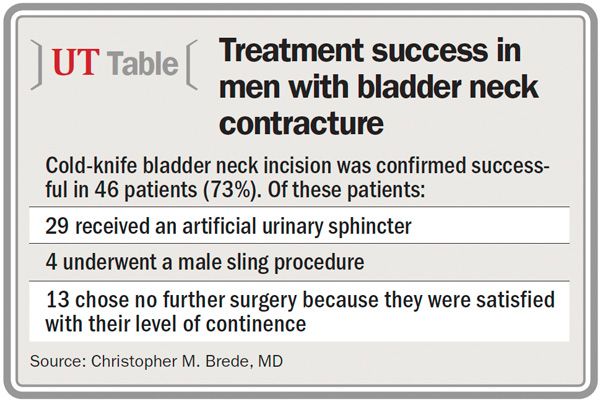Article
BNI plus AUS or sling efficacious for post-radical prostatectomy contracture
Findings from a 15-year retrospective chart review of men treated for recalcitrant post-prostatectomy bladder neck contracture and incontinence offer insight for urologists on expected outcomes for this challenging patient population.
San Diego-Findings from a 15-year retrospective chart review of men treated for recalcitrant post-prostatectomy bladder neck contracture (BNC) and incontinence offer insight for urologists on expected outcomes for this challenging patient population.
In addition, the experience reinforces that these men constitute a diverse group of patients who may be optimally managed using a broad armamentarium of surgical techniques, according to researchers from Cleveland Clinic’s Glickman Urological & Kidney Institute Center for Genitourinary Reconstruction, Cleveland.
The authors identified 63 men who had been referred for recalcitrant BNC (inability to pass a 17F flexible cystoscope) after prior treatment with bladder neck incision (BNI) or dilation. Stress incontinence was the predominant continence complaint.
Management was undertaken in a two-stage sequence, beginning with deep cold-knife BNI. Men returned 3 to 4 months later for cystoscopic evaluation, and those whose BNC was stable and patent were offered further surgery for incontinence with placement of an artificial urinary sphincter (AMS 800, American Medical Systems, Minnetonka, MN) or male urethral sling (AdVance, American Medical Systems). All of the procedures were performed by senior author Kenneth W. Angermeier, MD, or co-author Hadley M. Wood, MD.
BNI was confirmed successful in 46 (73%) of the 63 men, of whom 29 received an AUS, four had a male sling procedure, and 13 chose no further surgery because they were satisfied with their level of continence. Four men were categorized as BNI failures and underwent suprapubic tube placement or permanent surgical diversion, and the remaining 13 men were either lost to follow-up with outcome of BNI unknown (seven patients), still awaiting evaluation after an initial or repeat BNI (four patients), or had died (two patients).
66% rate of continence observed
Continence was achieved without further intervention by all four men who had a sling procedure and by 25 of 27 men with an AUS available for follow-up. In addition, one AUS patient who still needed one pad per day became dry after secondary sling surgery, while the other AUS failure underwent permanent diversion. Overall, 42 men (66%) achieved satisfactory continence after BNI and either a single or no additional operation.

“Published information on outcomes of management for post-prostatectomy BNC and incontinence is not very robust, as the literature contains only about half a dozen reports from groups describing different techniques for BNC management in case series of no more than 25 patients. To our knowledge, our analysis represents the largest experience with management of post-prostatectomy BNC and incontinence,” said first author Christopher M. Brede, MD, resident at Glickman Urological & Kidney Institute.
“Based on our findings, we feel confident counseling men that they have at least a two-thirds chance of being satisfied with their level of dryness after BNI alone or with a single additional operation. However, we believe our series also highlights that it is important for reconstructive urologists be able to offer a range of techniques.”
Heterogeneous population
The study’s population was heterogeneous with respect to the patients’ clinical presentations and history of treatment for both prostate cancer and BNC, Dr. Brede observed. Nine men (14%) had concurrent membranous strictures, about one-fourth had received adjuvant radiation, and the number of prior BNC procedures ranged from one to 12.
“It was interesting to note the diversity in the timing of referral from other urologists, and also that the number of prior incisions or having a history of radiation did not seem to affect the ultimate outcome,” he said.
“However, the group that failed, while relatively small, in general included men who had the most complicated history, such as with radiation, previous urethral reconstruction attempts, and previous attempts at AUS or sling placement.”
Dr. Angermeier is a consultant/adviser to American Medical Systems.UT





